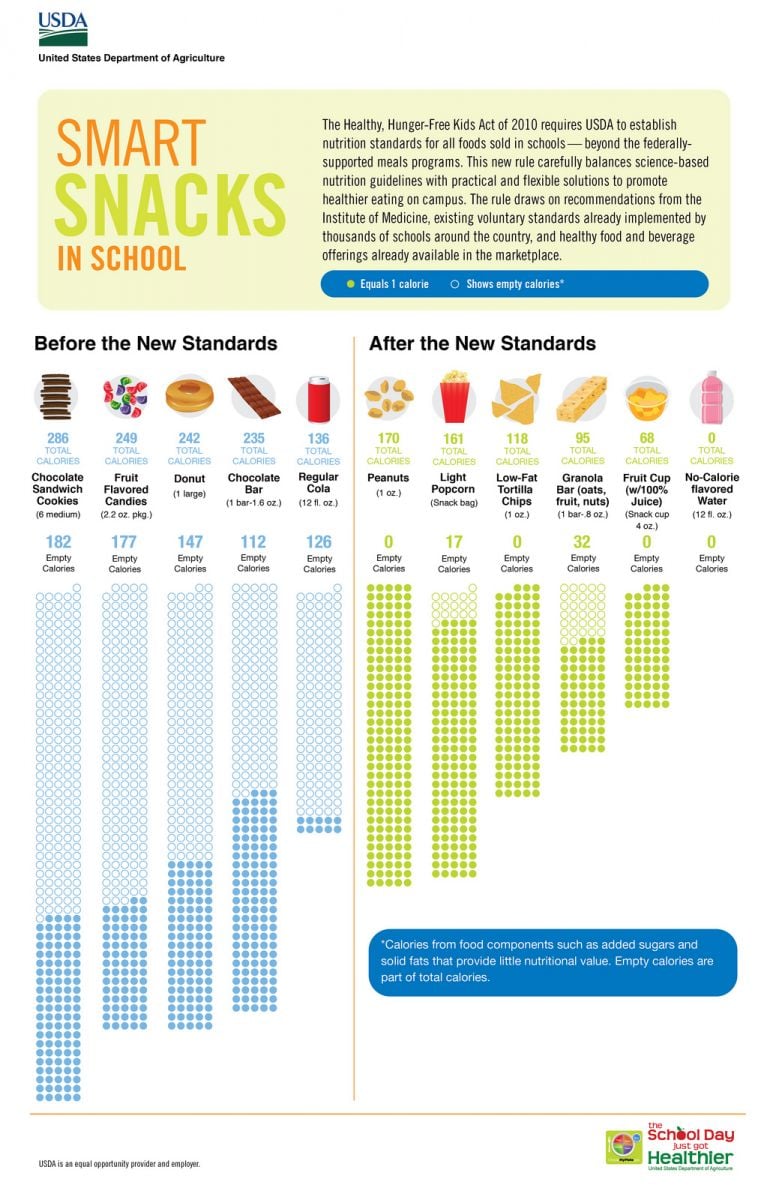Making All School Food Healthier: New Guidelines for Competitive Foods
The Bipartisan Policy Center’s (BPC) Nutrition and Physical Activity Initiative applauds the United States Department of Agriculture (USDA) for the release of the “Smart Snacks in School” nutrition standards, an important step toward ensuring that students have plenty of healthy food choices during school hours. These new national standards will improve the nutritional quality of competitive foods available in schools, such as snack foods sold in vending machines and school stores. We are pleased to see that the interim final rule aligns with many of the recommendations we made in our June 2012 report, Lots to Lose: How America’s Health and Obesity Crisis Threatens Our Economic Future, and in the comments BPC submitted on the proposed rule this spring.* The new guidelines will make more nutritious beverages and foods available to students from elementary through high school and help create an environment that makes healthy choices easier, starting them on the path towards a lifetime of healthy eating.
Students spend a significant amount of their time in school and the USDA reports that many students eat at least one snack food each day at school. So-called “competitive foods,” such as chips, candy and soda, which are available in many school stores, vending machines and as “à la carte” items in cafeterias, compete with foods offered in school meal programs. According to a recent study by USDA’s Economic Research Service, desserts, sweetened beverages, salty snacks, and candy made up more than half of competitive items selected by elementary and secondary school students in 2005. Making sure that competitive foods also support students’ ability to make healthy food choices is an important component of ensuring that the whole school food environment supports students’ well-being. Nearly 80% of Americans support better guidelines for all foods sold in schools, according to the Kids’ Safe and Healthful Foods Project.
The new “Smart Snacks in School” guidelines are based on recommendations from the Institute of Medicine (IOM) and on existing voluntary competitive food rules. They will go into effect at the beginning of the 2014-2015 school year. These new guidelines will require that competitive foods be rich in nutritious ingredients, such as fruit, vegetables, whole grain, dairy, or protein, while also placing common sense limits on calories, sugar, fats, and sodium. Beverages with minimal nutritional value are restricted (such as full-calorie sodas and sports drinks), as is caffeine for elementary and middle school students. Additionally, the guidelines require that schools provide drinking water at no cost for students during meals beginning in the upcoming 2013-2014 school year. Together with the recently updated National School Lunch Program and School Breakfast Program guidelines, which were changed for the first time in 15 years by the Healthy Hunger-Free Kids Act (HHFKA) of 2010, the new “Smart Snacks in School” standards provide students with a full range of opportunities during the school day to make healthy choices, and make those healthy choices easier.
In our June 2012 Lots to Lose report, BPC highlighted the need for aggressive implementation of the HHFKA, and specifically recommended that regulations for competitive foods align with the updated school meal standards, so we are pleased that the new competitive food guidelines are moving forward. The “Smart Snacks in School” rule sets minimum requirements for competitive foods, allowing state and local education agencies to institute more stringent requirements if they choose to. While many states and localities had some existing competitive food policies, analyses by the CDC and others showed wide variation in scope and strength of requirements; few came close to meeting recommended IOM standards. Implementation of federal guidelines will ensure that all students enjoy a baseline level of healthy choices, with the flexibility for schools to create stricter standards if desired.
We recognize that the new standards will require time and effort to implement in some schools, particularly in smaller schools and school districts. To help facilitate implementation, we recommended several strategies outlined in our comments submitted to the USDA this spring. For example, we recommended that USDA, in partnership with outside organizations, develop a clearinghouse of tools and information, and that state implementation plans focus on training and other support necessary for successful implementation, monitoring, and enforcement. Sharing ideas and effective strategies will be particularly helpful for schools just beginning the task of making competitive foods healthier. These schools can benefit from the experiences of others that have already tested more stringent competitive standards. We continue to encourage the sharing of tools and expertise between all invested parties, including other government agencies such as the Department of Education, to support schools during this transition toward healthier school food environments and to maximize the impact of these improved nutrition standards.
The “Smart Snacks in School” nutrition guidelines are one more important step toward improving the health of our children by ensuring the school environment provides a full range of healthy choices. We encourage the USDA to provide schools around the nation with the technical support they need to fully and efficiently implement these new guidelines in their current form. Our health and the health of our children depend on healthy behaviors and a healthy environment. School leadership to implement USDA’s competitive food rules will support both elements by ensuring that the entire school food environment provides the foundation for our children to make healthy food choices.
Sarah Mott serves as a summer intern with BPC’s Nutrition and Physical Activity Initiative and is a graduate student in public health at the University of Michigan.
Source: USDA
Share
Read Next
Support Research Like This
With your support, BPC can continue to fund important research like this by combining the best ideas from both parties to promote health, security, and opportunity for all Americans.
Give Now